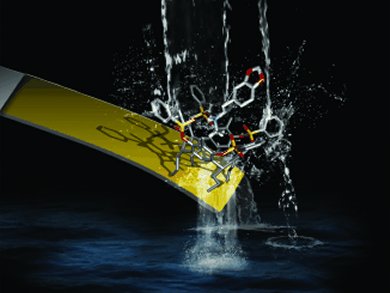Nanomechanical Detection of Methamphetamines and Designer Drugs
The widespread use of methamphetamines and related designer drugs is a major challenge for our society, with significant impact on health and social security. In the journal Angewandte Chemie, Italian researchers have introduced a new method of detection that allows the entire class of methamphetamine drugs to be detected in water. A probe equipped with synthetic receptor molecules responds to a grouping of atoms that is present in all methamphetamines. The chemical variations of the different designer drugs have no effect.
Callenges of Detecting Designer Drugs
A large variety of analytical methods for the detection of methamphetamines have been developed, most of which are slow to yield results or require complicated operations such as labor-intensive sample preparation. The identification of designer drugs presents a further challenge. These compounds are based on an existing drug whose chemical structure has been slightly altered. Although the effect of the drug is not changed by these modifications, they do cause serious problems for current detection methods, which are optimized for the identification of specific substances and usually cannot recognize related drugs with a different structure. The demand for a sensitive, selective method for the rapid detection of methamphetamines and designer drugs in the field is correspondingly high.
New Method
Scientists from the Universities of Parma, Brescia, and Catania have now successfully met this challenge. Their new method is based on molecular recognition and a nanomechanical detector. The team led by Paolo Bergese and Enrico Dalcanale grafted concave molecules called cavitands to a cantilever made of silicon. Such cantilevers are used as probes for atomic force microscopes. An array of such grafted cantilevers is used to probe the surface of an aqueous sample. If a cavitand comes into contact with a methamphetamine molecule, the molecule is bound. This molecular recognition is transformed into a mechanical response, which is converted into a deflection of the cantilever.
The cavitands were designed so that a single molecule reliably “recognizes” the methylamino group common to all methamphetamine-based drugs by way of a synergistic set of weak interactions. The chemical variations inherent in designer drugs do not interfere with the recognition by the synthetic receptor. Other substances typically mixed with the drug, usually glucose or lactose, do not disturb the detection either. The researchers were able to demonstrate the effectiveness of their technique with a variety of methamphetamine-based substances as well as real samples from the street.
- Cavitand-Grafted Silicon Microcantilevers as a Universal Probe for Illicit and Designer Drugs in Water,
Elisa Biavardi, Stefania Federici, Cristina Tudisco, Daniela Menozzi, Chiara Massera, Andrea Sottini, Guglielmo G. Condorelli, Paolo Bergese, Enrico Dalcanale,
Angew. Chem. Int. Ed. 2014.
DOI: 10.1002/anie.201404774




